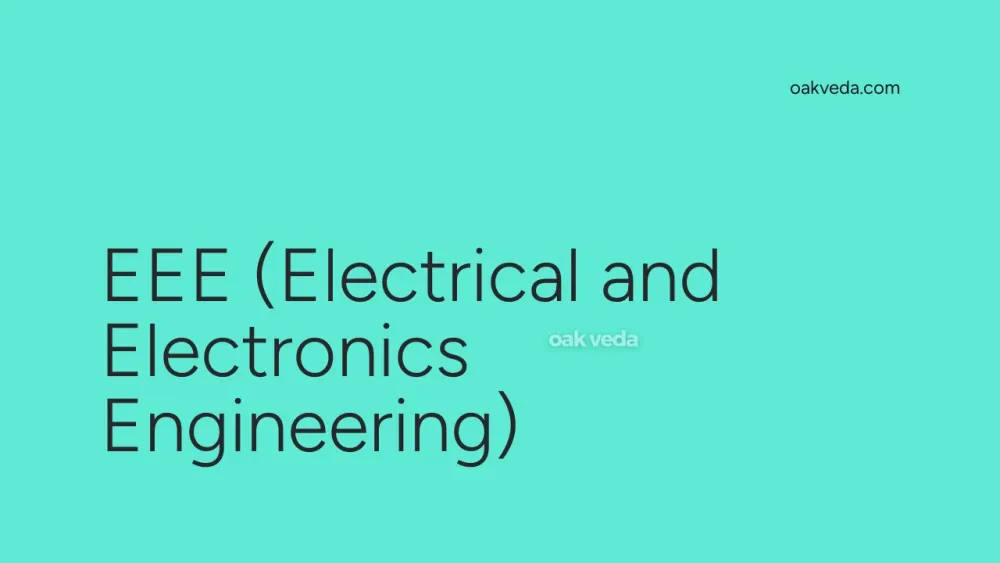
What is the Full Form of EEE?
The full form of EEE is Electrical and Electronics Engineering. This multifaceted discipline combines the principles of electrical engineering with the intricacies of electronics, forming a comprehensive field that powers our modern world.
What is Electrical and Electronics Engineering?
Electrical and Electronics Engineering (EEE) is a branch of engineering that focuses on the study, design, and application of equipment, devices, and systems which use electricity, electronics, and electromagnetism. It encompasses a wide range of sub-disciplines, including power systems, control systems, signal processing, and telecommunications.
Origin and Development of Electrical and Electronics Engineering
The field of EEE has its roots in the late 19th century with the invention of the telegraph and the telephone. As electricity became more prevalent, the need for specialized engineers grew. The 20th century saw rapid advancements in electronics, leading to the integration of electrical and electronic systems, thus giving birth to the modern EEE discipline.
How does Electrical and Electronics Engineering work?
EEE works by applying the principles of physics and mathematics to electrical and electronic systems. Engineers in this field:
- Design and develop electrical and electronic circuits
- Create and maintain power generation and distribution systems
- Develop control systems for various applications
- Work on signal processing and communication systems
- Innovate in areas such as robotics and automation
Functions of Electrical and Electronics Engineering
The primary functions of EEE include:
- Power Generation and Distribution: Designing and maintaining electrical grids
- Circuit Design: Creating efficient and innovative electronic circuits
- Control Systems: Developing systems for industrial automation and robotics
- Signal Processing: Working on communication systems and data analysis
- Instrumentation: Designing and implementing measurement and control devices
Applications of Electrical and Electronics Engineering
EEE finds applications in numerous sectors:
- Telecommunications: Developing mobile networks and internet infrastructure
- Automotive Industry: Designing electrical systems for vehicles, including electric cars
- Aerospace: Creating avionics and control systems for aircraft and spacecraft
- Consumer Electronics: Innovating in smartphones, computers, and home appliances
- Healthcare: Developing medical imaging equipment and biomedical devices
- Energy Sector: Working on renewable energy systems and smart grids
Features of Electrical and Electronics Engineering
Key features of EEE include:
- Interdisciplinary Nature: Combines electrical, electronic, and computer engineering
- Innovation-Driven: Constantly evolving with technological advancements
- Problem-Solving Oriented: Focuses on practical solutions to real-world challenges
- High Demand: Offers diverse career opportunities across various industries
Benefits of Electrical and Electronics Engineering
Pursuing a career in EEE offers numerous benefits:
- Diverse Career Opportunities: EEE graduates can work in various sectors
- High Earning Potential: Generally offers competitive salaries
- Technological Impact: Contributes to cutting-edge innovations
- Global Demand: Skills are transferable across countries
- Continuous Learning: Evolving field ensures lifelong learning opportunities
Limitations or Challenges of Electrical and Electronics Engineering
Despite its advantages, EEE also faces some challenges:
- Rapid Technological Changes: Requires constant updating of knowledge and skills
- Complex Problem-Solving: Deals with intricate systems and theories
- Safety Concerns: Working with high-voltage systems can be hazardous
- Environmental Impact: Some electrical systems can have negative environmental effects
Future Developments in Electrical and Electronics Engineering Technology
The future of EEE is exciting, with developments expected in:
- Renewable Energy: Advanced solar and wind power systems
- Internet of Things (IoT): Interconnected smart devices and systems
- Artificial Intelligence: Integration of AI in electrical and electronic systems
- Quantum Computing: Development of quantum electronic devices
- 5G and Beyond: Advanced communication technologies
FAQs on EEE Full Form
-
What is the eligibility criteria for pursuing EEE? Typically, students need to complete 12th grade with Physics, Chemistry, and Mathematics, securing at least 50% marks.
-
Which are some top institutions offering EEE courses in India? Some renowned institutions include IIT Guwahati, Delhi Technological University, IIT Varanasi, Anna University Chennai, and NIT Tiruchirappalli.
-
What are the main responsibilities of an EEE engineer? EEE engineers focus on research, design, development, and production of electronic and electrical equipment, automation systems, and power networks.
-
Is EEE different from ECE? Yes, while EEE focuses more on power systems and electrical machines, ECE (Electronics and Communication Engineering) emphasizes communication systems and signal processing.
-
What are the career prospects for EEE graduates? EEE graduates can pursue careers in power companies, telecommunications, automotive industries, aerospace, and more. They can work as design engineers, systems engineers, or project managers.
In conclusion, Electrical and Electronics Engineering (EEE) is a dynamic and crucial field that continues to shape our technological landscape. From powering our homes to enabling global communications, EEE plays a vital role in modern society. As technology advances, the importance and scope of this field are only set to grow, making it an exciting and rewarding career choice for aspiring engineers.
You may be interested in:

